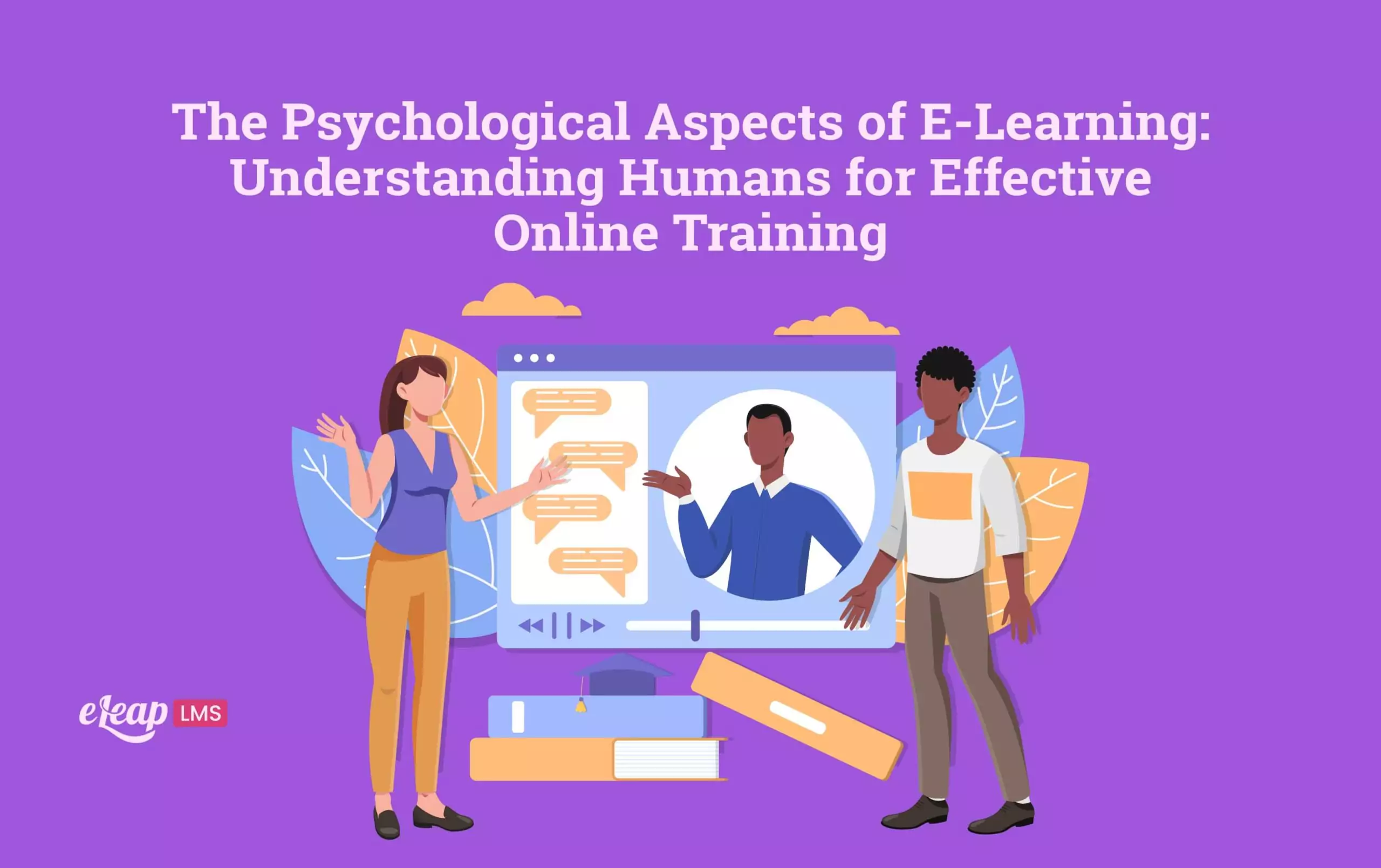The Psychological Aspects of E-Learning: Understanding Humans for Effective Online Training

At this time of the digital revolution, eLearning has gradually become an indispensable tool for Effective Online Training and education. However, technology is not the only force that makes eLearning effective; an in-depth understanding of the user’s psychology is also crucial.
In this detailed article, we’ll dig deep to enlighten you about the psychological aspects of human behavior that influence eLearning. By the time you finish this article, you will be able to develop techniques to create and deliver online content that supports and engages your learners. Let’s get started!
Humans Will Do Only As Much As They Have To
The human mind is naturally designed to focus and absorb minute information at a time. Thus, in the world of eLearning, people want to grab the information they need as quickly as they can and concentrate on other activities.
Strategies To Resolve This
- Design your content to help learners complete it at their pace.
- Share a bit of information, and give them the option to choose if they want to learn more.
- Go straight to the bone of contention. Avoid unnecessary or repetitive information; otherwise, they’ll lose interest, ignore the training, and end up not completing the course. Exposing learners to more than they require can clutter up their learning experience.
People Learn Through Retention And Spaced Practice
Although this fact of learning is usually ignored in technology and the fast-paced corporate world, it is almost impossible to learn something in a day and recollect it from then on. Yes, it’s possible to know something, and it’ll stick to you long enough to ace a test. After this, you can easily forget the things you learn.
Therefore, unless humans consistently study, there’s a probability that they’ll forget all they learn.
Strategies To Resolve This
- Design your content with small chunks of learnable information.
- Include a review of the previous sections for each new section. The art of spaced practice will aid your learners in recollecting the previous teachings, even on the last slide. This strategy works well for recollection, and this explains why it’s popular even in the movie industry.
People Have Diverse Learning Styles
A regular human is good at learning some courses and bad at others. For instance, someone who’s extremely good at Mathematics might not do so well with English. This is because the person’s learning style resonates more with Mathematics than English. Some people are visual learners; they grasp things by watching or seeing someone explain it to them. Some other people learn by writing or reading about a subject. Another set of people may quickly grasp things only by learning hands-on; they learn by practicing or doing it themselves.

Strategies To Resolve This
- Include several content styles in one course.
- Offer plenty of textual information, mixing it with a healthy amount of visual and audio aids and hands-on activities that can fit in.
Human Mind Organizes Information According To The Way It’s Learned
The order of learning things is essential as it determines how we consume, retain, and recall information. A practical instance is how we learned to solve mathematical equations, a step at a time. If we skip any step, there’s a high chance of not arriving at the correct answer.
Strategy To Resolve This
- Include a hierarchy of organization in the process of developing your eLearning content. This means breaking down the content into smaller, more manageable chunks, grouping related content together and presenting it in a clear and concise way. You should arrange the hierarchy so that it guides the learners through the material in a logical order and helps them understand how the different topics relate to each other.
The Human Mind Is Curious
Humans are naturally curious; they prefer to learn and discover information beyond what you present to them. When something catches the human interest, they want to go above and beyond to learn more. The more curious humans are, the more questions they have and the more time they’ll devote to learning.
As an eLearning designer, you can stimulate and arouse the curiosity of humans to increase their interest or attract their attention.
Strategy To Resolve This
- Start the content by asking probing questions. If they can’t answer the question, they get engaged and attached to the course in search of answers.
Humans Are Social Beings That Learn Better Together
Whether they admit it or not, humans need social reinforcement. People are likely to learn better when they learn together with others. Humans look to others for guidance on what to do, especially when uncertain.
Strategy To Resolve This
- Offer a medium for them to provide and receive feedback. It boosts their motivation to learn. Create an interaction opportunity; it could be a blog or forum.
Humans Need Relevancy
For information to be stored permanently, it should be relatable to people’s daily lives. Thus, you should structure your content in a way that makes it applicable to human life. This will help them retain the information for a longer period instead of temporarily retaining it to pass a test. It’s no wonder why mathematical concepts are reinforced with practical examples.
Strategy To Resolve This
- Reinforce your content with strategies and examples that will make it relatable to humans’ everyday life.
The Human Brain Works Better At Different Times In A Day
Depending on their nature, humans comprehend assimilate at different times of the day. While some are highly active in the morning, some get super-active after a nap, and others during nighttime.
Strategy To Resolve This
- Create a flexible module schedule that enables your learners to learn at any time of the day.
Besides having opposable thumbs, the one thing that differentiates humans from the animals in the kingdom is our brain. We have the ability to think and to reason. When developing e-Learning courses, it is imperative to understand how humans think and process information. Understanding the psychological aspect of learning can help you break through to the attendees to ensure that they maximize their learning.
 Importance Supersedes Distractions
Importance Supersedes Distractions
When a person deems something is important, they tend to pay attention. For e-learning content developers, this is important because it reveals you should focus your content on the most significant points. The human brain can juggle three to four important points at a time, so try to limit the topics or areas covered in your e-Learning courses to the top three to four points.
People Want to Work at a Minimum Level
Human brain design allows humans to process information in bits and pieces. This is how you should present content, information and material in an e-Learning course. Break down entire courses into modules, chapters or sections. Feed information to attendees one module, chapter or section at a time. This puts the learner in the driver’s seat so they can decide how much information they want to tackle at a time. Typically, humans want to work as little as possible so they can finish the training and get back to work.
Humans are Social Beings
Working with other individuals motivates humans. Social networking facts and figures should drive this point home. Even when humans are using cell phones, computers or tablets, they want to socialize and interact with other human beings. Answer this need in developing your e-Learning course. Infuse ways attendees can compete with each, talk with each other online or somehow interact to meet their socializing needs, even though they can complete the training on their own.
People Desire Information
People love to be in the know. It fulfills their curiosity. Curious human beings seek out the answers to questions they have. Use this to your advantage when developing online training courses. Provide the information the audience members are seeking. Ensure that you are providing this desired information by reading surveys, conducting surveys or uncovering studies that have the same audience members you are catering to with your training.
Everyone has a Limit
Think of the brain as an assembly line. Information goes into the brain and the brain starts pushing the information through. If the information is relevant and useful, humans are likely to store the information. If not, then a “brain dump” occurs and humans forget the information. Only include relevant and useful information that pertains to the course topic. This is the information attendees will store, which means that you reach your goal of training them.
In essence, humans act predictably. Once you understand how the human brain works and how humans think, it makes developing your online training materials faster and easier. It also ensures that you create highly effective courses to help you reach your training goals.
Final Thoughts
E-Learning has rapidly become an essential aspect of modern education, and it’s crucial to understand the psychological aspects of e-learning for effective online training. Therefore, the success of this modern learning program depends on the ability to connect with learners on an emotional and psychological level. By understanding human behavior and learning preferences, e-learning platforms can create engaging and effective training programs that promote knowledge retention and improved learning outcomes.
- What Is The Value Of Training Contingent Workers?
- Want to Convey a Message? Put It In an Infographic
- Performance Management: New Directions in Appraisal and Evaluation – The Autodesk Case Study.
- 5 E-Learning Tools You Can’t Live Without
- How to Overcome the Challenges of Training a Global Workforce with e-Learning
- Principles of Grouping for eLearning
- How to Spot the Hidden Costs When Selecting an LMS